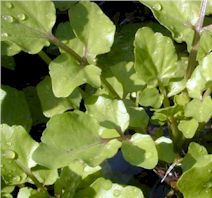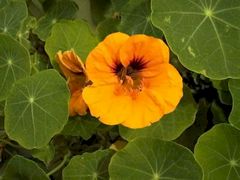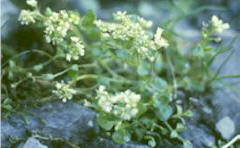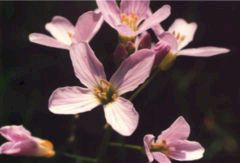The Cress of the herbalist is a noun of multitude: it comprises several sorts, differing in kind but possessing the common properties of wholesomeness and pungency. Here "order in variety we see"; and here, "though all things differ, all agree." The name is thought by some to be derived from the Latin verb crescere, to grow fast.
Each kind of Cress belongs to the Cruciferous genus of plants; whence comes, perhaps, the common name The several varieties of Cress are stimulating and anti-scorbutic, whilst each contains a particular essential principle, of acrid flavor, and of sharp biting qualities. The whole tribe is termed lepidium, or "siliquose," scaly, with reference to the shape of the seed-pouches. It includes "Land Cress (formerly dedicated to St. Barbara); Broad-leaved Cress (or the
Poor-man's pepper); Penny Cress (thlapsus); Garden, or Town Cress; and the well known edible Water Cress." Formerly the Greeks attached much value to the whole order of Cresses, which they thought very beneficial to the brain. A favorite maxim with them was, "Eat Cresses, and get wit."
In England these plants have long been cultivated as a source of profit; whence arose the saying that a graceless fellow is not worth a "kurse" or cress in German, kers. Thus Chaucer speaks about a character in the Canterbury Tales, "Of paramours ne fraught he not a kers." But some writers have referred this saying rather to the wild cherry or kerse, making it of the same significance as our common phrase, "Not worth a fig."
As Curative Herbal Simples we need only consider the Garden or Town Cress, and the Water Cress: whilst regarding the other varieties rather as condiments, and salad herbs to be taken by way of pleasant wholesome appetizers at table. These aromatic herbs were employed to season the homely dishes of our forefathers, before commerce had brought the spices of the East at a cheap rate to our doors; and Cresses were held in common favour by peasants for such a purpose. The black,
or white pepper of to-day, was then so costly that "to promise a saint yearly a pound of it was considered a liberal bequest." And therefore the leaves of wild Cresses were eaten as a substitute for giving pungency to the food. Remarkable among these was the Dittander Sativus, a species found chiefly near the sea, with foliage so hot and acrid, that the plant then went by the name of "Poor-man's Pepper," or "Pepper Wort." Pliny said, "It is of the number of scorching
and blistering Simples." "This herbe," says Lyte, "is fondly and unlearnedly called in English Dittany. It were better in following the Dutchmen to name it Pepperwort."
 |
The Garden Cress, called Sativum (from satum, a pasture), is the sort commonly coupled with the herb Mustard in our familiar "Mustard and Cress." It has been grown in England since the middle of the sixteenth century, and its other name Town Cress refers to its cultivation in "tounes," or enclosures. It was also known as Passerage; from passer, to drive away--rage, or
madness, because of its reputed power to expel hydrophobia. "This Garden Cress," said Wm. Coles in his Paradise of Plants, 1650, "being green, and therefore more qualified by reason of its humidity, is eaten by country people, either alone with butter, or with lettuce and purslane, in |
Sallets, or otherwise."
It contains sulphur, and a special ardent volatile medicinal oil. The small leaves combined with those of our white garden Mustard are excellent against rheumatism and gout. Likewise it is a preventive of scurvy by reason of its mineral salts. In which salutary respects the twin plants, Mustard and Cress, are happily consorted, and well play a capital common part, like the "two single gentlemen rolled into one" of George Colman, the younger.
 |
The Water Cress (Nasturtium officinale) is among cresses, to use an American simile, the "finest toad in the puddle." This is because of its superlative medicinal worth, and its great popularity at table. Early writers called the herb "Shamrock," and common folk now-a-days term it the "Stertion." Zenophon advised the Persians to feed their children on Water-cresses (kardamon esthie)
that they might grow in stature and have active minds.
The Latin name Nasturtium was given to the Watercress because of its volatile pungency when bruised and smelt; from nasus, a nose, and |
tortus, turned away, it being so to say, "a herb that wriths or twists the nose." For the same reason it is called Nasitord in France. When bruised its leaves affect the eyes and nose almost like mustard. They have been usefully applied to the scald head and tetters of children. In New Zealand the stems grow as thick as a man's wrist, and nearly choke some of the rivers. Like an oyster, the Water-cress is in proper season only when there is an "r" in the month.
According to an analysis made recently in the School of Pharmacy at Paris, the Water-cress contains a sulpho-nitrogenous oil, iodine, iron, phosphates, potash, certain other earthy salts, a bitter extract, and water. Its volatile oil which is rich in nitrogen and sulphur (problematical) is the sulpho-cyanide of allyl. Anyhow there is much sulphur possessed by the whole plant in one form or another, together with a considerable quantity of mineral matter. Thus the popular
plant is so constituted as to be particularly curative of scrofulous affections, especially in the spring time, when the bodily humors are on the ferment. Dr. King Chambers writes (Diet in Health and Disease), "I feel sure that the infertility, pallor, fetid breath, and bad teeth which characterize some of our town populations are to a great extent due to their inability to get fresh anti-scorbutic vegetables as articles of diet: therefore I regard the Water-cress
seller as one of the saviors of her country." Culpeper said pithily long ago: "They that will live in health may eat Water-cress if they please; and if they won't, I cannot help it."
The scrofula to which the Water-cress and its allied plants are antidotal, got its name from scrofa, "a burrowing pig," signifying the radical destruction of important glands in the body by this undermining constitutional disease. Possibly the quaint lines which nurses have long been given to repeat for the amusement of babies while fondling their infantine fingers bear a hidden meaning which pointedly imports the scrofulous taint. This nursery distich, as we remember,
personates the fingers one by one as five little fabulous pigs: the first small piggy doesn't feel well; and the second one threatens the doctor to tell; the third little pig has to linger at home; and the fourth small porker of meat has none; then the fifth little pig, with a querulous note, cries "weak, weak, weak" from its poor little throat.
"oegrotat multis doloribus porculus ille:
Ille rogat fratri medicum proferre salutem:
Debilis ille domi mansit vetitus abire;
Carnem digessit nunquam miser porculus ille;
'Eheu!' ter repetens, 'eheu!' perporculus, 'eheu!'
Vires exiguas luget plorante susurro."
On account of its medicinal constituents the herb has been deservedly extolled as a specific remedy for tubercular consumption of the lungs. Haller says: "We have seen patients in deep declines cured by living almost entirely on this plant;" and it forms the chief ingredient of the Sirop Antiscorbutique given so successfully by the French faculty in scrofula and other allied diseases. Its active principles are at their best when the plant is in flower; and the amount
of essential oil increases according to the quantity of sunlight which the leaves obtain, the proportion of iron being determined according to the quality of the water, and the measure of phosphates by the supply of dressing afforded. The leaves remain green when grown in the shade, but become of a purple brown because of their iron when exposed to the sun. The expressed juice, which contains the peculiar taste and pungency of the herb, may be taken in doses of from one to
two fluid ounces at each of the three principal meals, and it should always be had fresh. When combined with the juice of Scurvy grass and of Seville oranges it makes the popular antiscorbutic medicine known as "Spring juices."
A Water-cress cataplasm applied cold in a single layer, and with a pinch of salt sprinkled thereupon makes a most useful poultice to heal foul scrofulous ulcers; and will also help to resolve glandular swellings.
Water-cresses squeezed and laid against warts were said by the Saxon leeches to work a certain cure on these excrescences. In France the Water-cress is dipped in oil and vinegar to be eaten at table with chicken or a steak. The Englishman takes it at his morning or evening meal, with bread and butter, or at dinner in a salad. It loses some of its pungent flavor and of its curative qualities when cultivated; and therefore it is more appetizing and useful when freshly gathered
from natural streams. But these streams ought to be free from contamination by sewage matter, or any drainage which might convey the germs of fever, or other blood poison: for, as we are admonished, the Water-cress plant acts as a brush in impure running brooks to detain around its stalks and leaves any dirty disease-bringing flocculi.
Some of our leading druggists now make for medicinal use a liquid extract of the Nasturtium officinale, and a spirituous juice (or succus) of the plant. These preparations are of marked service in scorbutic cases, where weakness exists without wasting, and often with spongy gums, or some skin eruption. They are best when taken with lemon juice.
The leaf of the unwholesome Water parsnip, or Fool's Cress, resembles that of the Water-cress, and grows near it not infrequently: but the leaves of the true Water-cress never embrace the stem of the plant as do the leaf stalks of its injurious imitators. Herrick the joyous poet of "dull Devonshire" dearly loved the Water-cress, and its kindred herbs. He piously and pleasantly made them the subject of a quaint grace before meat:
"Lord, I confess too when I dine
The pulse is Thine:
And all those other bits that be
There placed by Thee:
The wurts, the perslane, and the mess
of Water-cress."
 |
The true Nasturtium (Tropoeolum majus), or greater Indian Cress grows and is cultivated in our flower gardens as a brilliant ornamental creeper. It was brought from Peru to France in 1684, and was called La grande Capucine, whilst the botanical title tropoeolum, a trophy, was conferred because of its shield-like leaves, and its flowers resembling a golden helmet. An old
English name for the same plant was Yellow Lark's heels.
Two years later it was introduced into England. This partakes of the |
sensible and useful qualities of the other cresses. The fresh plant and the dark yellow flowers have an odor like that of the Water-cress, and its bruised leaves emit a pungent smell. An infusion made with water will bring out the antiscorbutic virtues of the plant which are specially aromatic, and cordial. The flowers make a pretty and palatable addition to salads, and the nuts or capsules (which resemble the "cheeses" of Mallow) are esteemed as a pickle, or as a substitute
for Capers. Invalids have often preferred this plant to the Scurvy grass as an antiscorbutic remedy. In the warm summer months the flowers have been observed about the time of sunset to give out sparks, as of an electrical kind, which were first noticed by a daughter of Linnoeus.
The Water-cress is justly popular with persons who drink freely overnight, for its power of dissipating the fumes of the liquor, and of clearing away lethargic inaptitude for work in the morning: also for dispelling the tremors, and the foul taste induced by excessive tobacco smoking.
 |
Closely allied thereto is another cruciferous plant, the Scurvy grass (Cochleare), named also "Spoon-wort" from its leaves resembling in shape the bowl of an old-fashioned spoon. This is thought to be the famous Herba Britannica of the ancients. Our great navigators have borne testimony to its never failing use in scurvy, and, though often growing many miles from the sea, yet the taste of
the herb is always found to be salt. If eaten in its fresh state, as a salad, it is the most effectual of all the antiscorbutic plants, the leaves being |
admirable also to cure swollen and spongy gums. It grows along the muddy banks of the Avon, likewise in Wales, and is found in Cumberland, more commonly near the coast; and again on the mountains of Scotland. It may be readily cultivated in the garden for medicinal use.
 |
The Cuckoo flower, or "Ladies' Smock" (Cardamine) from Cardia damao, "I strengthen the heart," is another wholesome Cress with the same sensible properties as the Water-cress, only in an inferior degree, while the strong pungency of its flavor prevents it from being equally popular. This plant bears also the names of "Lucy Locket," and "Smell Smocks." In Cornwall the flowering tops have been
employed for the cure of epilepsy throughout several generations with singular success; though the use of the leaves only for this |
purpose has caused disappointment. From one to three drams of these flowering tops are to be taken two or three times a day.
By the Rev. Mr. Gregor (1793) and by his descendants this remedy was given for inveterate epilepsy with much benefit. Lady Holt, and her sister Lady Bracebridge, of Aston Hall, Warwickshire, were long famous for curing severe cases of the same infirmity by administering this herb. They gave the powdered heads of the flowers when in full bloom-twelve grains three times a day for many weeks together.
Sir George Baker in 1767 read a paper before the London College of Physicians on the value of these flowers in convulsive disorders. He related five cures of St. Vitus' dance, spasmodic convulsions, and spasmodic asthma. Formerly the flowers were admitted into the London Pharmacopoeia. The herb was named Ladies' Smock in honor of the Virgin Mary, because it comes first into flower about Lady Day, being abundant with its delicate lilac blossoms in our moist meadows and
marshes:
"Lady Smocks all silver white
Do paint the meadows with delight."
This plant is also named "Milk Maids," "Bread and Milk," and "Mayflower." Gerard says "it flowers in April and May when the Cuckoo cloth begin to sing her pleasant notes without stammering." One of his characters is made by the Poet Laureate to:
"Steep for Danewulf leaves of Lady Smock,
For they keep strong the heart."
"And so much," as says William Cole, herbalist, in his Paradise of Plants, 1650, "for such Plants as cure the Scurvy."






